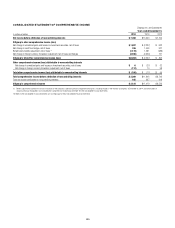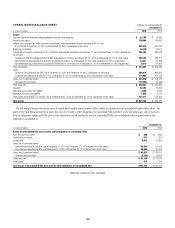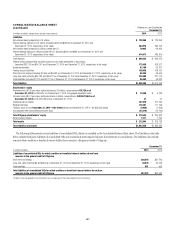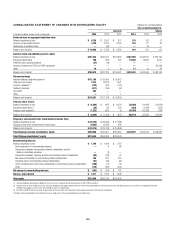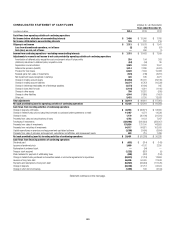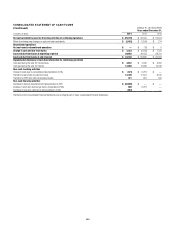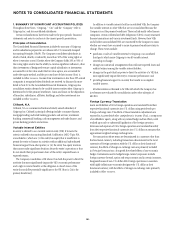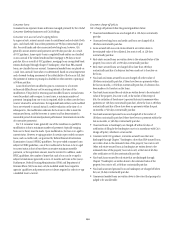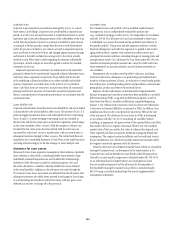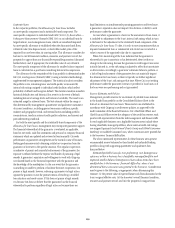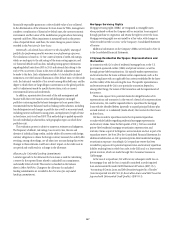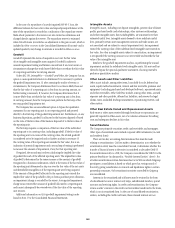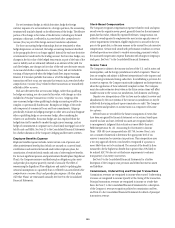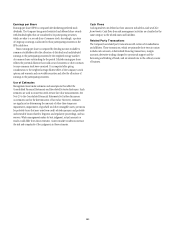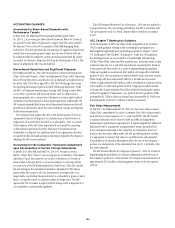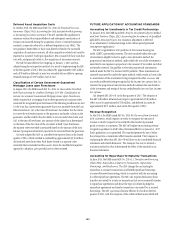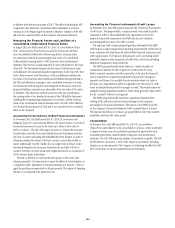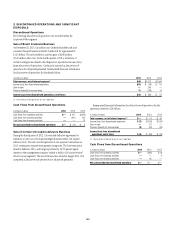Citibank 2014 Annual Report Download - page 162
Download and view the complete annual report
Please find page 162 of the 2014 Citibank annual report below. You can navigate through the pages in the report by either clicking on the pages listed below, or by using the keyword search tool below to find specific information within the annual report.145
Corporate loans
Corporate loans represent loans and leases managed by ICG or, to a much
lesser extent, Citi Holdings. Corporate loans are identified as impaired and
placed on a cash (non-accrual) basis when it is determined, based on actual
experience and a forward-looking assessment of the collectability of the loan
in full, that the payment of interest or principal is doubtful or when interest
or principal is 90 days past due, except when the loan is well collateralized
and in the process of collection. Any interest accrued on impaired corporate
loans and leases is reversed at 90 days and charged against current earnings,
and interest is thereafter included in earnings only to the extent actually
received in cash. When there is doubt regarding the ultimate collectability
of principal, all cash receipts are thereafter applied to reduce the recorded
investment in the loan.
Impaired corporate loans and leases are written down to the extent that
principal is deemed to be uncollectable. Impaired collateral-dependent loans
and leases, where repayment is expected to be provided solely by the sale
of the underlying collateral and there are no other available and reliable
sources of repayment, are written down to the lower of cost or collateral
value. Cash-basis loans are returned to accrual status when all contractual
principal and interest amounts are reasonably assured of repayment and
there is a sustained period of repayment performance in accordance with the
contractual terms.
Loans Held-for-Sale
Corporate and consumer loans that have been identified for sale are classified
as loans held-for-sale and included in Other assets. The practice of Citi’s U.S.
prime mortgage business has been to sell substantially all of its conforming
loans. As such, U.S. prime mortgage conforming loans are classified as
held-for-sale and the fair value option is elected at origination, with changes
in fair value recorded in Other revenue. With the exception of those loans
for which the fair value option has been elected, held-for-sale loans are
accounted for at the lower of cost or market value, with any write-downs or
subsequent recoveries charged to Other revenue. The related cash flows are
classified in the Consolidated Statement of Cash Flows in the cash flows from
operating activities category on the line Change in loans held-for-sale.
Allowance for Loan Losses
Allowance for loan losses represents management’s best estimate of probable
losses inherent in the portfolio, including probable losses related to large
individually evaluated impaired loans and troubled debt restructurings.
Attribution of the allowance is made for analytical purposes only, and
the entire allowance is available to absorb probable loan losses inherent
in the overall portfolio. Additions to the allowance are made through the
Provision for loan losses. Loan losses are deducted from the allowance and
subsequent recoveries are added. Assets received in exchange for loan claims
in a restructuring are initially recorded at fair value, with any gain or loss
reflected as a recovery or charge-off to the provision.
Consumer loans
For consumer loans, each portfolio of non-modified smaller-balance,
homogeneous loans is independently evaluated by product type
(e.g., residential mortgage, credit card, etc.) for impairment in accordance
with ASC 450-20. The allowance for loan losses attributed to these loans
is established via a process that estimates the probable losses inherent in
the specific portfolio. This process includes migration analysis, in which
historical delinquency and credit loss experience is applied to the current
aging of the portfolio, together with analyses that reflect current and
anticipated economic conditions, including changes in housing prices and
unemployment trends. Citi’s allowance for loan losses under ASC 450 only
considers contractual principal amounts due, except for credit card loans
where estimated loss amounts related to accrued interest receivable are
also included.
Management also considers overall portfolio indicators, including
historical credit losses, delinquent, non-performing and classified loans,
trends in volumes and terms of loans, an evaluation of overall credit quality,
the credit process, including lending policies and procedures, and economic,
geographical, product and other environmental factors.
Separate valuation allowances are determined for impaired smaller-
balance homogeneous loans whose terms have been modified in a troubled
debt restructuring (TDR). Long-term modification programs, as well as
short-term (less than 12 months) modifications originated beginning
January 1, 2011 that provide concessions (such as interest rate reductions)
to borrowers in financial difficulty, are reported as TDRs. In addition, loan
modifications that involve a trial period are reported as TDRs at the start
of the trial period. The allowance for loan losses for TDRs is determined
in accordance with ASC 310-10-35 considering all available evidence,
including, as appropriate, the present value of the expected future cash flows
discounted at the loan’s original contractual effective rate, the secondary
market value of the loan and the fair value of collateral less disposal costs.
These expected cash flows incorporate modification program default rate
assumptions. The original contractual effective rate for credit card loans is
the pre-modification rate, which may include interest rate increases under
the original contractual agreement with the borrower.
Valuation allowances for commercial market loans, which are classifiably
managed Consumer loans, are determined in the same manner as for
Corporate loans and are described in more detail in the following section.
Generally, an asset-specific component is calculated under ASC 310-10-35
on an individual basis for larger-balance, non-homogeneous loans
that are considered impaired and the allowance for the remainder of
the classifiably managed Consumer loan portfolio is calculated under
ASC 450 using a statistical methodology that may be supplemented by
management adjustment.


